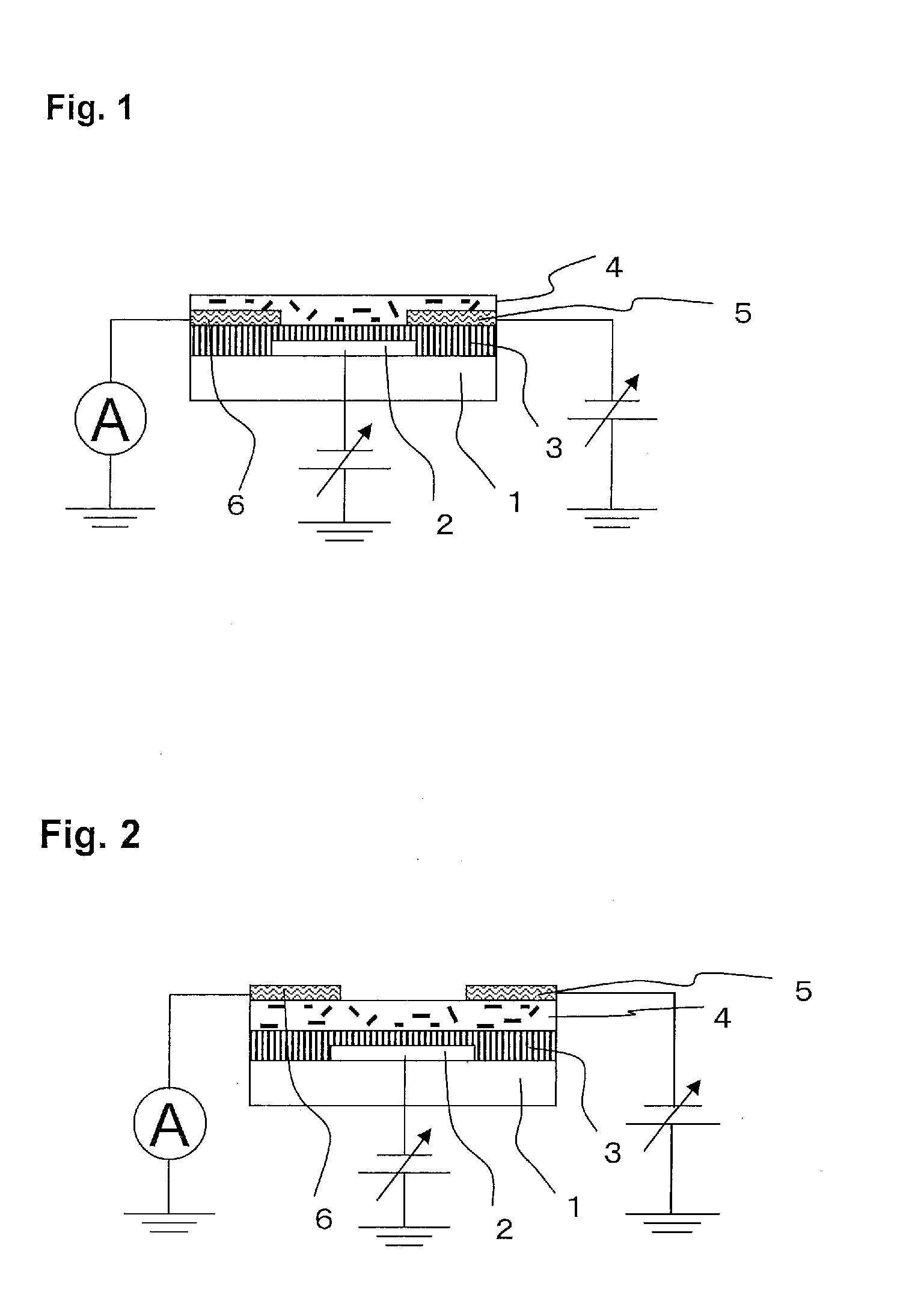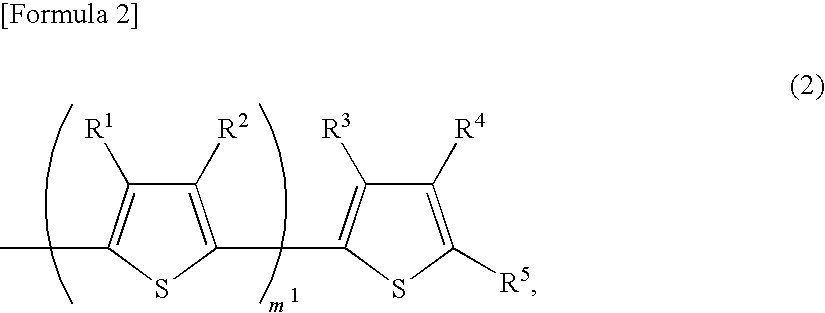Organic semiconductor composite, organic transistor material and organic field effect transistor
a technology of organic transistors and organic semiconductors, applied in the direction of non-metal conductors, conductors, nanoinformatics, etc., can solve the problems of difficult to realize the reduction of production costs or the enlargement of the area of inorganic semiconductors, difficult to reduce costs, and limited materials capable of being used as substrates. , to achieve the effect of high charge mobility and high on/off ratio
- Summary
- Abstract
- Description
- Claims
- Application Information
AI Technical Summary
Benefits of technology
Problems solved by technology
Method used
Image
Examples
synthesis example 1
Synthesis of Compound [7]
[0130]60 g of 3-n-hexylthiophene was dissolved in 400 ml of dimethylformamide, and to this, 50 g of N-bromosuccinimide was added. The resulting solution was stirred at room temperature for 4 hours under a nitrogen atmosphere. 200 ml of water and 200 ml of hexane were added to the resulting solution to separate the organic layer. The organic layer was washed with 200 ml of water and dried over magnesium sulfate, and then the solvent was distilled off under reduced pressure with a rotary evaporator to obtain 60 g of 2-bromo-3-n-hexylthiophene.
[0131]Next, 4.3 g of magnesium powder and 10 mg of iodine were added to 100 ml of tetrahydrofuran and stirred for 30 minutes under a nitrogen atmosphere. To this, a mixture of 42 g of 2-bromo-3-n-hexylthiophene described above and 100 ml of tetrahydrofuran was added dropwise, and heated to reflux for 1 hour. The mixture was cooled to room temperature and a mixture of 20 g of 5,5′-dibromo-2,2′-bithiophene and 200 ml of tet...
synthesis example 2
Synthesis of Compound [6]
[0136]After a mixture of 16.3 g of 4T described above and 20 ml of tetrahydrofuran was cooled to −30° C., 21 ml of n-butyllithium solution (1.6 mol / l hexane solution) was added dropwise, and stirred at room temperature for 1 hour. The resulting mixture was cooled to −10° C., and 5.7 g of 2-isoporopoxy-4,4,5,5-tetramethyl-[1,3,2]dioxaborolane was added thereto and stirred at room temperature, for 3 hours. 33 ml of a 1N aqueous solution of hydrochloric acid, 200 ml of water and 200 ml of dichloromethane were added to the resulting solution to separate the organic layer. The organic layer was washed with 100 ml of water and then dried over magnesium sulfate. The resulting solution was concentrated by a rotary evaporator and was purified by a column chromatography (filler: silica gel, eluent: hexane / dichloromethane) to obtain 11 g of 4T-BPin represented by the following formula.
[0137]7.2 ml of ethanol, 12 ml of a 2N aqueous solution of sodium carbonate and 30 mg...
synthesis example 3
Synthesis of Compound [34]
[0140]A mixture of 3.1 g of 4,4′-bis(chloromethyl)biphenyl and 8.6 ml of triethylphosphite was stirred at 150° C. for 5 hours. The mixture was cooled to room temperature, and 50 ml of dimethylsulfoxide and 2.8 g of potassium t-butoxide were added to the mixture and stirred at room temperature for 10 minutes. Subsequently, 4.9 g of 3-hexyl-2-thiophene aldehyde was added thereto and stirred at room temperature for 5 hours. 30 ml of ethanol was added to the resulting solution and the precipitate was filtered to obtain a solid. The obtained solid was washed with 20 ml of ethanol to obtain 2.8 g of TPV represented by the following formula.
[0141]1.78 g of N-bromosuccinimide was added to a mixture of 2.8 g of TPV described above and 30 ml of dimethylformamide, and stirred at room temperature for 10 hours under a nitrogen stream. The resulting solution was filtered and the precipitate was washed with 10 ml of dimethylformamide and 20 ml of methanol to obtain 1.4 g ...
PUM
| Property | Measurement | Unit |
|---|---|---|
| Semiconductor properties | aaaaa | aaaaa |
Abstract
Description
Claims
Application Information
 Login to View More
Login to View More - R&D
- Intellectual Property
- Life Sciences
- Materials
- Tech Scout
- Unparalleled Data Quality
- Higher Quality Content
- 60% Fewer Hallucinations
Browse by: Latest US Patents, China's latest patents, Technical Efficacy Thesaurus, Application Domain, Technology Topic, Popular Technical Reports.
© 2025 PatSnap. All rights reserved.Legal|Privacy policy|Modern Slavery Act Transparency Statement|Sitemap|About US| Contact US: help@patsnap.com



